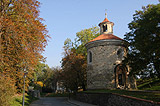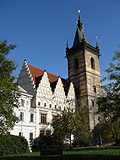Some Doubts of Christmas and Christmas Markets in Prague
Dec 18, 13:50 Filed under czech-traditions
Christmas is coming and as you’ve probably noticed, cities around the world are being covered in glamour. That includes Prague of course, which is getting its load of artificial lights, souvenirs and markets on key squares.
On one hand we all know those shiny things on buildings, lamps and trees are fake. They are supposed to express an outburst of joy, the overall happiness, a result of the fact that Christmas will be here soon. But I doubt many people would overlook the somber calculation behind the strategy. It’s a labored hunt for the customer, with a different convention, a different face. I believe this is good to keep in mind, though I’m not sure it’s wrong.
We could definitely call it pretension from both sides. The money-makers are pretending they wish to spread comfort by having the city decorated, they pretend they want to give Prague a special atmosphere. We are pretending we believe it. We should definitely keep this fact in mind, but still we can enjoy the game. It’s still fairly positive. No matter what the motives are, it does give the city a special feeling, the centre feels alive and healthy.
There’s the traditional Christmas tree on the Old Town Square, for example. Some 20 meters high, the tree from Krkonose mountains may not be a marvel for a passer-by. It does have some power though, it’s part of the illusion of unity, maybe sharing some similarities with the primitive societies’ gathering points- the main gathering point of Christmas lies in the circle around it. The number of light bulbs on its body is irrelevant.
Commerce is of course behind all this. It works well because we have a special situation here: the customers are not only willing to buy, they’re also less sensitive to the prices than they are during the year. If you’re buying a gift for someone close, you can’t look for the cheapest things possible, you’re more likely to express your affection by the opposite: buying things that are far more expensive than those you’d ever acquire for yourself.
 I really don’t thing there’s anything wrong with all this. I have only three points. First we should be aware of it. Second, the aesthetic aspect should be considered, the decorations being quite well-fitting for the more commercial parts of the city, but it’s a difficult question whether historical parts should be involved. Third, the blood on the sidewalk is not a part of modern Christmas. I am referring to the needless slaughter of carps- I mean what is the point of choosing the live fish and having it killed in front of you? Some illusion of being “closer to the nature”?
I really don’t thing there’s anything wrong with all this. I have only three points. First we should be aware of it. Second, the aesthetic aspect should be considered, the decorations being quite well-fitting for the more commercial parts of the city, but it’s a difficult question whether historical parts should be involved. Third, the blood on the sidewalk is not a part of modern Christmas. I am referring to the needless slaughter of carps- I mean what is the point of choosing the live fish and having it killed in front of you? Some illusion of being “closer to the nature”?
That aside, it’s mostly nice to see the end of the year approaching in the city center.
This article is here to balance articles like this one
 K-1 is a combat sport that combines stand up techniques from Muay Thai, Karate, Taekwondo, Savate, San shou, Kickboxing and traditional Boxing to determine the single best stand-up fighter in the world (the “1”). K-1 origined due to unceasing disputes and comparing single combat sports, and reasoning which style is more effective and better. “K” as a king and “1” as a king of kings. This is the main idea formed by Master Kazuyoshi Ishii in 1993. Ingenious is that the rules are simple and understandable for laymen as well. Fighters with different weights and styles meet at a boxing ring and try to manage that their martial art is the best.
K-1 is a combat sport that combines stand up techniques from Muay Thai, Karate, Taekwondo, Savate, San shou, Kickboxing and traditional Boxing to determine the single best stand-up fighter in the world (the “1”). K-1 origined due to unceasing disputes and comparing single combat sports, and reasoning which style is more effective and better. “K” as a king and “1” as a king of kings. This is the main idea formed by Master Kazuyoshi Ishii in 1993. Ingenious is that the rules are simple and understandable for laymen as well. Fighters with different weights and styles meet at a boxing ring and try to manage that their martial art is the best. 

 In the Czech Republic there is a very nice tradition of celebrating Saint Nicholas eve. Nicholas was a pious man, a bishop of Myra (in today’s Turkey) who lived in 3rd and 4th century. In those times, when Christians were persecuted, he did a lot in order to help them and was very popular for his charitable activities.
In the Czech Republic there is a very nice tradition of celebrating Saint Nicholas eve. Nicholas was a pious man, a bishop of Myra (in today’s Turkey) who lived in 3rd and 4th century. In those times, when Christians were persecuted, he did a lot in order to help them and was very popular for his charitable activities.  Dutch gothic metal band Within Temptation will visit
Dutch gothic metal band Within Temptation will visit  International Jazz Festival is one of the oldest jazz festivals in Europe. It takes place in dates 22nd – 30th November 2007.
International Jazz Festival is one of the oldest jazz festivals in Europe. It takes place in dates 22nd – 30th November 2007.  Many of the changes were of course results of wars. At this moment I wish to point out the major changes done decisively and coordinated from the centre of power or those dictated by an immediate need.
Many of the changes were of course results of wars. At this moment I wish to point out the major changes done decisively and coordinated from the centre of power or those dictated by an immediate need.  It was notably the nineteenth century which brought a major growth of the city, often as a result of speculation and massive interest in building and enlarging. The end of the century was the worst: during some twenty years, the face of the Old town was changed as much as possible.
It was notably the nineteenth century which brought a major growth of the city, often as a result of speculation and massive interest in building and enlarging. The end of the century was the worst: during some twenty years, the face of the Old town was changed as much as possible.